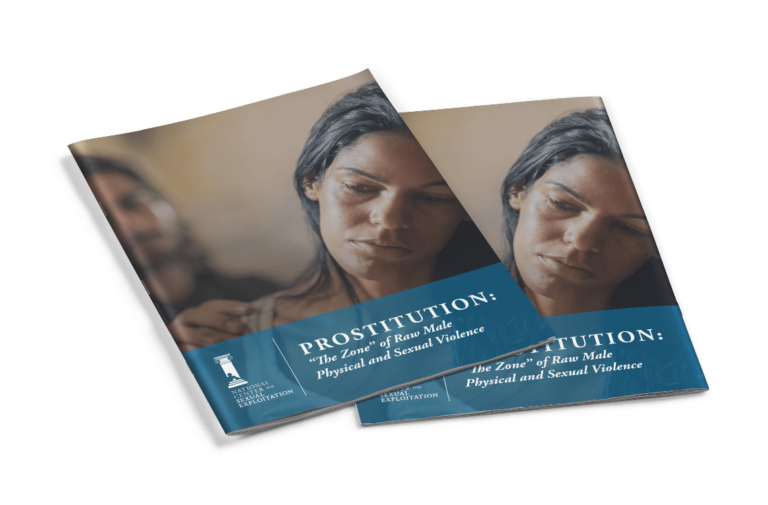
Prostitution is commonly defined as the exchange of sexual conduct for money or other things of value (such as food or shelter).
Those profiting from prostitution present it as harmless, much like any other commercial transaction, but the reality for people in prostitution is far darker. Coercion, force, fraud, and deeply rooted social injustices are necessary to make prostitution possible. In contrast to how it is presented in mainstream media, prostitution typically involves payment for unwanted and degrading sex acts, and is not like other work in which one is paid for their time and effort.
The common starting point for those sold in the sex trade is as a child or young adult with a history of neglect and sexual abuse, forced by others or coerced by desperate circumstances. In the U.S., buyers are disproportionately white men with money (see here, here, and here) compared to those used in prostitution, who are frequently poor and disproportionately persons of color (see here and here). By the time people used in prostitution exit the sex trade, the vast majority have been subjected to a wide range of physical and psychological traumas (see here, here, and here), have chronic health problems as a result, have retained little of the income they generated, and have limited hope for employment as a result of missed opportunities for education and work experience.
10 Reasons to Oppose Full Decriminalization of Prostitution
Prostitution is widely acknowledged by both proponents and opponents as being inherently dangerous, but there are strongly opposing views about the most effective ways for minimizing risks. Laws addressing prostitution fall in three main categories:
- Prohibition legally bans prostitution for all parties and seeks its prevention or abolition.
- Legalization establishes laws and regulations allowing prostitution to function as a type of legitimate business if it operates within specified parameters.
- Full decriminalization eliminates legal and most regulatory restrictions on prostitution, allowing it to function freely in response to market forces.
There are also partial decriminalization models that borrow elements of the other basic approaches. For instance, the Abolition Model (also known as the Swedish, Nordic, or Equality Model) decriminalizes the sale of sex but keeps prohibitions on buyers and profiting from prostitution. The evidence is overwhelming that legalization and decriminalization expand prostitution markets and increase sex trafficking, thus generating more physical and psychological trauma for current and future victims.

Decriminalized prostitution refers to the removal of laws criminalizing all or some aspects of the sex trade. Full decriminalization seeks to decriminalize all parties involved in the facilitating, buying, and selling of sex. Thus, “full” decriminalization refers to the repeal of laws pertaining to pimping, brothel keeping, and sex buyers, as well as those who are sold for sex. This model not only removes criminal penalties on all those involved in prostitution, but also seeks to create a prostitution marketplace that has little, if any, regulatory oversight.
A different form of decriminalization known as partial decriminalization—commonly referred to as the Abolition model—removes criminal penalties for prostitution only for individuals involved in the selling of sex (i.e., prostituting persons). At the same time, this model increases criminal penalties for those who buy sex and provides funding for programs to assist prostituting persons with resources and supports to exit the sex trade.
In contrast, legalized prostitution is generally understood to be regulated prostitution, although the term may also be used to refer to jurisdictions where there is no law explicitly prohibiting prostitution. Under systems of legalized prostitution, various regulations governing how commercial sex transactions are to be conducted are instituted. Such regulations may include brothel licensing requirements and restrictions on where brothels can be located, as well as establishing requirements that prostituting persons officially register with the government, undergo compulsory health checks, and pay taxes on proceeds from prostitution.
A third approach to prostitution is known as prohibition. Under this approach, all prostitution is viewed as criminal activity and all activities connected with prostitution (i.e., soliciting, procuring, pimping, brothel keeping) are criminalized.
A 2013 study of 150 countries from the London School of Economics found that where prostitution was legal, sex-trafficking increases.
Furthermore, the state of Nevada (the only state in the U.S. with legalized prostitution in select counties) has the largest sex trade in the country, adjusted for population. It is 63% higher than the next highest state of New York and double that of California.
Why? Because once something is legal, there is an increased demand for it.
This, combined with the fact that prostitution is inherently dangerous and harmful, means there is never a sufficient supply of people available to be purchased for sex. This creates opportunity for sex traffickers who push victims into the sex trade through force, fraud, or coercion in order to make a profit off of the high demand for commercial sex.
It is also important to note that it is essentially impossible for sex buyers to vet and know if the person they are purchasing for sex is a sex trafficking victim or not. Most sex trafficking victims are not held in dungeons with literal chains but are instead “trapped” through use of psychological coercion and threats.
America is known for the bonanza of choices it presents to those living within its borders and the freedom it extends to those individuals to pursue them. From the trivial, like what kind of milk (i.e., skim, 1%, 2%, whole, dairy, almond, soy, and a wide assortment of blends) and coffee we drink (ice mocha latte with a shot of espresso, anyone?), to the serious, like the occupations we pursue and those we elect—and everything in between—America affords its residents a cornucopia of choices.
In this context, supreme value is placed on the ability to choose, but not on what is chosen. As long as a perception of the freedom to choose exists, most people are happy to let others pursue whatever course they will. However, this “it’s your choice” approach to life, is not without its downsides.
There are lots of choices one can make: to jaywalk, eat foods loaded with trans fat, drive above the speed limit, not wear a helmet while riding a motorbike, smoke or vape, handle a loaded gun, use opioids and many more. But as a civilized society we recognize that such choices are potentially harmful to the individuals who engage in them, as well as others around them who don’t. In light of these dangers, society attempts to make rules, restrictions, and barriers to such activities, and in some cases even bans them. Why should it be any different for an activity imbued with as much risk as prostitution?
Unfortunately, when it comes to prostitution many people assert that as long as prostitution is chosen, it no longer constitutes exploitation. Any harms that result are just the cost of poor decision making and the full responsibility of the person making the choice
According to this view, no matter how injurious, dangerous, or pernicious the choice to prostitute may be, we must simply sit back and accept prostitution as a fact of life—as long as it is chosen. But as author and women’s advocate Rebecca Whisnant explains, “That something is chosen or consensual is perfectly consistent with its being seriously oppressive, abusive, and harmful—to oneself and/or to a broader group of which one is a member (e.g., women).” We wholeheartedly agree.
To the extent that prostitution is ever truly a choice (for most of the people in it, it most decidedly is not), it’s a choice fraught with danger, and not just run-of-the-mill workplace dangers (like slipping on wet floors), but physical and sexual violence that includes things like stabbings, rape, gang-rape, degrading sexual acts, choking/strangulation, beatings with fists or hard objects, kidnapping, stalking, threat with a firearm, and torture—to mention a few. (For more on the physical and sexual violence native to prostitution, see our booklet Prostitution: “The Zone” of Raw Male Physical and Sexual Violence.)
Given this degree of potential physical harm, prostitution is not a choice that any progressive or caring society would sanction. But that’s exactly what happens when governments legalize or decriminalize prostitution—they choose to allow the vulnerable, the desperate, and the reckless to become the prey of the greedy, powerful, selfish, and lascivious. They choose to ensure that a pool of persons are always on supply as public, sexual property, disregarding the harm to those who are sold for sex.
Ironically, the debate about choice in prostitution is always focused on those with the least power and control in the whole equation: the prostituting person. It’s time to discuss the choices of those with the real power—sex buyers, pimps, corporate interests, and governments—and hold them accountable for their choices to promote and participate in sexploitation.
Those who care about people in the sex trade can choose not to build on ramps to sexploitation by fully decriminalizing or legalizing prostitution, but to shrink the opportunities for pimps and sex buyers to operate by creating and enforcing tough penalties on their activities and fostering pathways out of prostitution for those already in it. This is the only choice that fosters human dignity and flourishing.
The advocacy group Women Hurt in Systems of Prostitution (WHISPER) developed a powerful tool that communicates the extent of the harms experienced by persons in prostitution: a “job” description. Few things undermine the myth of “sex work” like a detailed list of exactly what people caught up in the sex trade are expected to do—night after night, month after month, year after year. For those readers of stout mind and heart, you can read that prostitution “job” description here. However, for those who are triggered by depictions of sexual abuse and violence, do yourself a favor and skip the link. We’ll try to convey WHISPER’s message more delicately in what follows but please understand that there is nothing delicate about the sex of prostitution.
One of the main points at the heart of the debate about the full decriminalization of prostitution (by this we mean the removal of all laws and any regulations around prostitution, the removal of which infer a right for persons to barter and trade other persons for sexual consumption in brothels, strip and night clubs, street corners) is what one believes about work.
While there are several meanings ascribed to the term, for the purpose of this discussion work should be understood as the labor, task, or duty that is one’s means of livelihood. For most people work is a necessary part of ensuring one’s survival: we work as the means to earn our wages and to sustain ourselves and those we love. For some, work may be a drudgery, a toil to be endured; for others, it may be a passion—a lifelong pursuit of one’s deepest interests and aspirations. From banking, engineering, janitorial service, the insurance industry, food service, education, medical professions, agriculture, journalism, law enforcement, aviation, to horticulture and beyond, there are a myriad of occupations in which one may work.
But this work is typically pursued within parameters. As a society we recognize that work should be performed within certain boundaries, and thus create rules concerning how it is carried out, such as the number of hours and days per week one must work, the number of sick days granted, and the minimum wages one can be paid. We also define certain conditions in which the work must be carried out—for instance mitigating the risk of injuries due to environmental hazards, and prohibiting certain activities such as smoking or drug use in the workplace, as well as racial discrimination and sexual harassment and abuse.
It hasn’t always been this way. Current labor conditions in the United States are the result of generations of reforms (and even a civil war which resulted in a constitutional prohibition of slavery). And, while the current American labor context is no panacea, in many parts of the world others dream of working under the rights and protections ascribed to American workers.
But whether one lives and works in the United States, Germany, Brazil, India, South Africa, Thailand, or anywhere else on the planet, what does it mean if one’s livelihood by means of prostitution is a normalized form of work?
It means that that your daily existence will likely entail:
- routine verbal degradation;
- threat of physical assault and a wide array of physical injury;
- extreme risk of sexual assault and rape;
- being groped, pinched, licked, bitten and breathed upon by people who pay to use you;
- serial utilization of one’s orifices as a receptacle for male genitalia and other objects;
- likely acquisition of alcohol and/or drug addiction;
- likely acquisition of post-traumatic stress disorder;
- likely acquisition of any number of (potentially incurable) STDs; and
- possible premature death as the result of homicide.
In practical terms, it also means that while you experience these abuses and injuries:
- others will have a “right” to profit from the sale of your body;
- others will have a “right” to sexually access your body as long as they paid to do so (and even if they don’t);
- sexual harassment, assault, and rape are on-the-job requirements;
- law enforcement will look the other way, as no “crimes” have been committed;
- the public will at best turn a blind eye to your plight, or at worst mock your abuse by calling it “your job.”
Thus, experiences that the rest of the world’s workers are protected from–or, at a minimum, compassionate members of society believe they should be protected from–comprise the core duties and conditions of “employment” for those in prostitution. Some “job.”
At NCOSE we recognize that the overwhelming majority of persons in prostitution around the world have turned to prostitution not because it’s a fantastic experience and they love the “benefits,” but because they were groomed for it, sold into it, can’t escape it, and/or have no other means to support themselves.
But whatever the circumstances by which they became entangled in the sex trade, we believe people deserve better than prostitution. We believe sexual exploitation is nobody’s “job.”
Proponents of legalizing or fully decriminalizing prostitution often claim that doing so will empower individuals in the sex trade to practice safe sex. Unfortunately, this is not true.
For instance, a study on sex buyers in Australian communities with legalized or fully decriminalized brothel-based prostitution reveals that sex buyers still encourage one another, and pressure prostituted persons, to practice unsafe sex.
The study notes:
- “Sex buyers frame unsafe sex practices as both an expected part of the sexual encounter and as a feature of the brothel experience that women are expected to be comfortable with and acquiesce to. When women are reported as showing signs that they are uncomfortable about unprotected sex, or require more payment to perform it, punters construct the experience in negative terms.” (Page 1897)
- “One of the ways men (re)produce a culture of unsafe sex within the forum is through the discussion of ‘extras,’ a term used to describe sex acts that violate the OHS regulations of decriminalized brothels or the legal requirements of safe sex in legalized brothels. These acts include penetrative vaginal, anal, or oral sex without a condom or dental dam.” (Page 1896)
- “Narratives that promote violating the safety and boundaries of women are presented as an achievement for men.” (Page 1897)
- “In [instances where women are unenthusiastic about unsafe sex practices], punters tended to rate the “service,” and the woman, negatively. (Page 1897)
Example of a Sex Buyer Review Negatively Complaining about Safe Sex. Note that sex buyers’ talk in online forums drive more “business” to prostituted persons who engage in unsafe sex.
- “[S]tarted with a [condomless blow job] ok but not spectacular then sex in a few positions thought good to finish with oral but goes down with condom on wtf. I gave up decided to end and count my money good bye. (March 2014; VIC)”
Take Action
Danger in the Desert
Share Your Story
Lawsuit Against Twitter
Demand Forum
Are You A Survivor of Sex Trafficking?


50%
9x
Further Reading
Research: Estimating the Sex Buying Behavior of Adult Males in the U.S.
Research: Are Men Who Buy Sex Different from Men Who Do Not?
Demand for Prostitution
Combating Demand is Crucial for Protecting Victims of Prostitution
Research: American Adult Pornography Consumer’s Beliefs and Behaviors Related to Pornography Studios Mistreating Their Performers
Demand for Prostitution
Research: Are Men Who Buy Sex Different from Men Who Do Not?
Research: Estimating the Sex Buying Behavior of Adult Males in the U.S.
Best Practices to Address the Demand Side of Sex Trafficking
Video Resources
Subscribe to our YouTube channel for the latest webinars, presentations from experts, video podcasts, and more!
Audio Resources
Subscribe to the Ending Sexploitation Podcast today!
The Ending Sexploitation podcast decodes sexual harms and provides you with active solutions. We address the full spectrum of sexual exploitation, from sex trafficking to sexual violence, to rape culture, to pornography, and more. And better yet, we give you the tools to make a difference!


